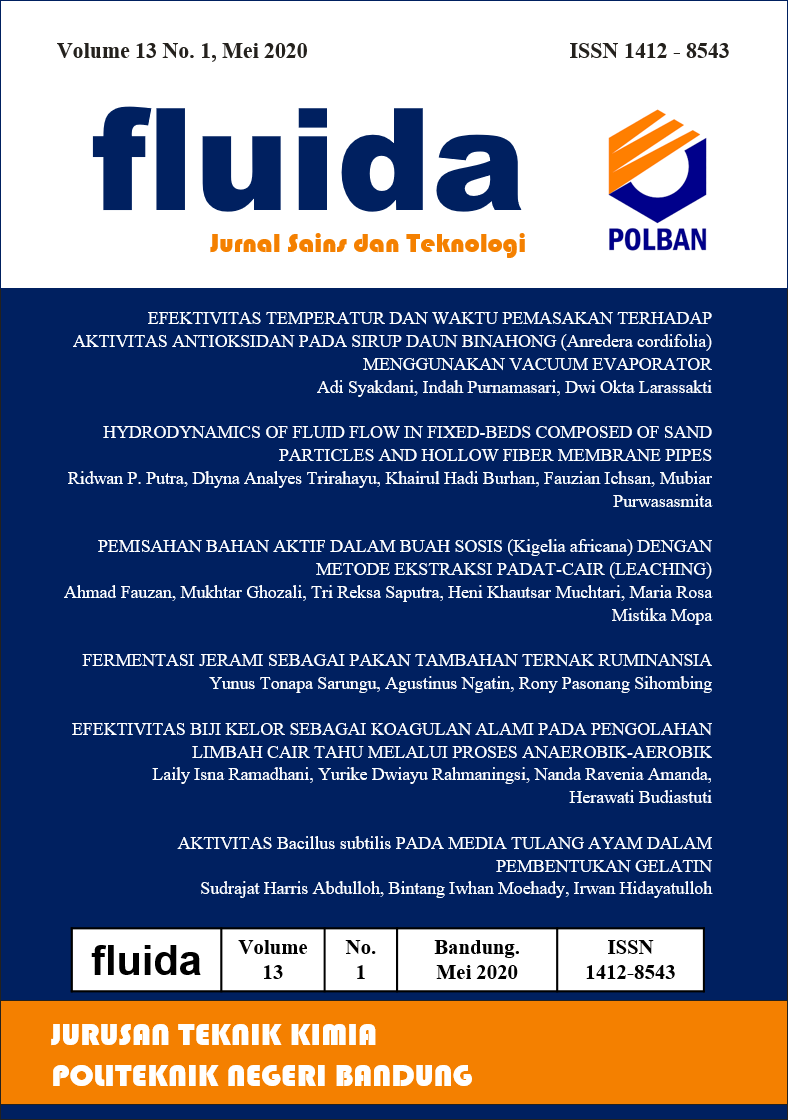Efektivitas Biji Kelor sebagai Koagulan Alami pada Pengolahan Limbah Cair Tahu Melalui Proses Anaerobik-Aerobik
Main Article Content
Abstract
ABSTRAK
Limbah cair tahu merupakan salah satu limbah cair dengan kandungan organik yang tinggi dan berpotensi merusak lingkungan. Pada penelitian ini digunakan dua metode pengolahan dengan mengkombinasikan metode pengolahan biologi dan proses koagulasi-flokulasi menggunakan koagulan alami, biji kelor. Tujuan dari penelitian ini adalah mempelajari pengaruh dosis dan ukuran partikel koagulan terbaik. Dosis biji kelor divariasikan dari 1.000, 2.000, 3.000, dan 4.000 ppm. Dosis terbaik digunakan untuk menentukan ukuran partikel koagulan terbaik dengan variasi ukuran 250, 500, 1.000, dan 2.000 µm. Hasil penelitian menunjukkan bahwa dosis biji kelor terbaik untuk metode 1 (aerobik dan koagulasi flokulasi) adalah 2.000 ppm dan untuk metode 2 (kombinasi anaerobik-aerobik dan koagulasi flokulasi) adalah 4.000 ppm. Ukuran partikel terbaik yaitu 500 µm untuk kedua metode dengan efisiensi penurunan kekeruhan sebesar 94,57% untuk efluen metode 1 dan 78,28% untuk efluen metode 2.
Kata kunci: Limbah cair tahu, biji kelor,koagulan alami, koagulasi- flokulasi
ABSTRACT
Tofu wastewater is one of the pollutant wastewater that potentially cause the serious damage to the environment due to its high organic content. The combination of biology method in the help of microorganism and coagulation-flocculation method using kelor seed were applied in this study. This research aims were determining the best dose and the optimum size of coagulant. Doses variation were 1,000, 2,000, 3,000 and 4,000 ppm of coagulant. The best dose resulted would be used to determine the optimum size of coagulant by variating 250, 500, 1,000 and 2,000 µm. The result showed that 2,000 ppm was the best coagulant dose for the first method (aerobic and coagulation-flocculation method) and 4,000 ppm was the optimum dose for the second method (combination of anaerobic-aerobic and coagulation-flocculation method). 500 µm was determined as the optimum particle size of the coagulant for both methods with % removal turbidity level were 94,57% for the first method and 78,28% for the second method.
Keywords:Tofu wastewater, kelor seed, natural coagulant, coagulation-flocculation
Downloads
Article Details

This work is licensed under a Creative Commons Attribution-ShareAlike 4.0 International License.
An author who publishes in the FLUIDA journal agrees to the following terms:
- Author retains the copyright and grants the journal the right of first publication of the work simultaneously licensed under the Creative Commons Attribution-ShareAlike 4.0 License that allows others to share the work with an acknowledgement of the work's authorship and initial publication in this journal
- Author is able to enter into separate, additional contractual arrangements for the non-exclusive distribution of the journal's published version of the work (e.g., post it to an institutional repository or publish it in a book) with the acknowledgement of its initial publication in this journal.
- Author is permitted and encouraged to post his/her work online (e.g., in institutional repositories or on their website) prior to and during the submission process, as it can lead to productive exchanges, as well as earlier and greater citation of the published work (See The Effect of Open Access).
Read more about the Creative Commons Attribution-ShareAlike 4.0 Licence here: https://creativecommons.org/licenses/by-sa/4.0/.
References
Gurnham, C. F. (1955). Principles of industrial waste treatment. New York: John Wiley and Sons, Inc.
Hendrawati, Nurhasni, & Syamsumarsih. (2003). Penggunaan Biji Asam Jawa ( Tamarindus Indica L.) dan Biji Kecipir (Psophocarpus tetragonolobus L.) sebagai Koagulan Alami dalam Perbaikan Kualitas Air Tanah. Valensi ISSN : 1978- 8193 UIN Syarif Hidayatullah, 3, 2233.
Hidayat, S. (2009). Protein Biji Kelor Sebagai Bahan Aktif Penjernihan Air. Biospesies, 2(2), 12–17.
Hussain, S., Ghouri, A. S., & Ahmad, A. (2019). Pine cone extract as natural coagulant for puri fi cation of turbid water. Heliyon, 5, e01420.
Klašnja, M., Antov, M., Škrbic, B., & Šc, M. (2009). Removal of water turbidity by natural coagulants obtained from chestnut and acorn. Bioresource Technology, 100, 6639–6643.
Kristijarti, A. P., Suharto, I., & Marienna. (2013). Penentuan Jenis Koagulan dan Dosis Optimum untuk Meningkatkan Efisiensi Sedimentasi dalam Instalasi Pengolahan Air Limbah Pabrik Jamu X Disusun Oleh : Prof . Dr . Ign Suharto , APU Marieanna , ST Lembaga Penelitian dan Pengabdian kepada Masyarakat Univers.
Mishra, A., & Bajpai, M. (2006). The flocculation performance of Tamarindus mucilage in relation to removal of vat and direct dyes. Bioresource Technology, 97, 1055–1059.
Oktariany, A., & Kartohardjono, S. (2018). Effect of Coagulant Dosage on Tofu Industry Wastewater Treatment in Combination with Ultrafiltration Process using Polysulfone Membrane. E3S Web of Conferences, 67, 4004.
Rahmaningsih, Y. D., & Amanda, N. R. (2019). Penambahan Koagulan Biji Asam Jawa dan Biji Kelor dalam Hasil Pengolahan Anaerobik-Aerobik dan Aerobik Limbah Cair Tahu. Politeknik Negeri Bandung.
Wardani, F. A., & Agung, T. (2016). Pemanfaatan Biji Asam Jawa (Tamarindus Indica) sebagai Koagulan Alternatif dalam Proses Pengolahan Air Sungai. Jurnal Ilmiah Teknik Lingkungan, 7(2), 85–91.

